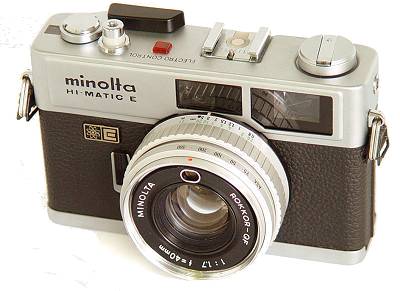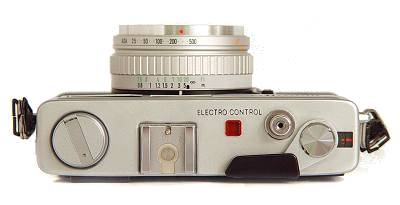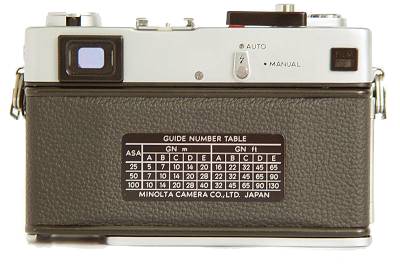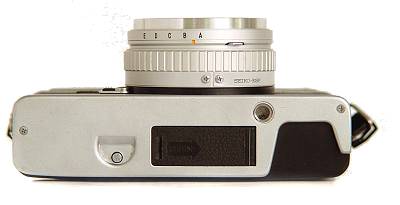|
The Hi-Matic E is one of the more recent models among the Minolta Hi-Matic rangefinders. Its outer dimensions is somewhere between the older Hi-Matic 7S, 9, or 11 models, which are quite a bit larger and the Hi-Matic 7S2, which is a little smaller. It was released by Minolta in 1971. The Hi-Matic E has an electronic EE seikosha shutter, on this camera termed "electro control", which in the seventies obviously stood for a modern and comfortable feature. Accordingly, next to the "E" on the front it presents a symbol showing electrons circling around an atom, very similar to the one found on the Yashica Electro rangefinders. The shutter works in a fully automatic program mode, which cannot be overridden by the user. There is no indication of the exposure values chosen, so the photographer does not have much control. There is a warning light in the viewfinder lighting up if the exposure time is longer than 1/30 s. That's all. The only means the photographer has to interfere is to change the ASA setting. This is fortunately possible in a comfortable manner, since the film speed is set via a ring on the lens barrel. On the other hand, it is very easy to change the ASA setting by accident... The camera is equipped with a beatiful Rokkor 1:1.7 lens with a semi wide focal lengt of 40 mm. If I am informed correctly, this is the same lens as in the Hi-Matic 7S2. It was constructed in cooperation with Leitz and compares well to the C-Summicron for the Leica CL and Minolta CLE. The Hi-Matic E has a very good viewfinder. It is extraordinarily bright and the framelines are well lit. There are not much other controls - the focusing ring, the film speed ring, self timer and a flash-mode switch. That's it. On the top cover there is a battery-check lamp lighting up when you press the shutter-release button halfway. The release button produces a rather loud and very strange sound, when it comes up after the exposure (rrzzzzzzzwwwwp). There is an automatic flash mode, which couples the aperture to the distance setting (a feature, which in the former Hi-matic models was termed "easy flash"). A corresponding symbol lights up in the viewfinder when a flash is inserted into the hot shoe. This automatic mode can be overriden - a busy table on the camera back transforms a given flash guide number and film speed into a letter A to E. The corresponding letter can be set on the film speed dial. The camera takes two PX640 mercury cells (1.35V). These are unavailable today. For my Hi-Matic E, I produced an adaptor allowing for the use of two SR44 or AG13 cells (1.5V). The higher battery voltage leads to a slightly wrong light-metering result - the image will be underexposed by about a half to one stop. This deviation can easily be accounted for by choosing an ASA setting one stop slower than the actual film speed. (Using e.g. a nominal ASA 100 film, set it to 50). Or you ignore the differnce - the previous considerations only hold for fresh batteries. Due to the rather steep voltage-time behaviour of alkaline and silver cells, the voltage rapidly drops below the nominal value. All in all a pretty camera but, due to the automatic mode and the corresponding lack of control over the exposure parameters, it is not one of my favourites. |
|




